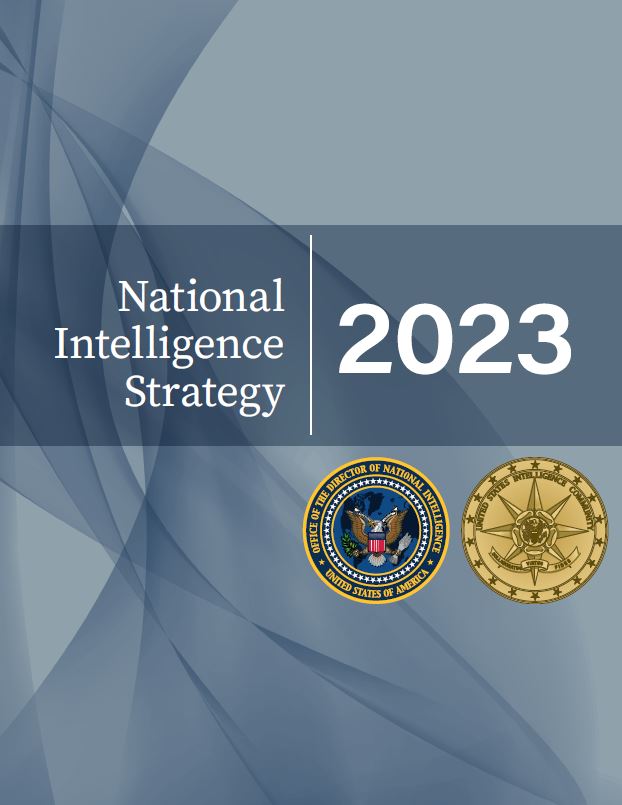Intelligence is information gathered within or outside the U.S. that involves threats to our nation, its people, property, or interests; development, proliferation, or use of weapons of mass destruction; and any other matter bearing on the U.S. national or homeland security. Intelligence can provide insights not available elsewhere that warn of potential threats and opportunities, assess probable outcomes of proposed policy options, provide leadership profiles on foreign officials, and inform official travelers of counterintelligence and security threats.
The U.S. Intelligence Community is a federation of executive branch agencies and organizations that work separately and together to conduct intelligence activities necessary for the conduct of foreign relations and the protection of the national security of the United States. The IC remains focused on the missions of cyber intelligence, counterterrorism, counterproliferation, counterintelligence, and on the threats posed by state and non-state actors challenging U.S. national security and interests worldwide.
Customers
The National Security Act of 1947, as amended, defines the Intelligence Community's customers as:
- The President
- National Security Council
- Heads of Departments and Agencies of the Executive Branch
- Chairman of the Joint Chiefs of Staff and senior military commanders
- Congress
Types of Intelligence
The intelligence cycle is a process of collecting information and developing it into intelligence for use by IC customers. The steps in the process are direction, collection, processing, exploitation, and dissemination.
IC products can either be based on a single type of collection or “all-source,” that is, based upon all available types of collection. IC products also can be produced by one IC element or coordinated with other IC elements, and delivered to IC customers in various formats, including papers, digital media, briefings, maps, graphics, videos, and other distribution methods.
There are six basic intelligence sources, or collection disciplines:
- SIGINT—Signals intelligence is derived from signal intercepts comprising -- however transmitted -- either individually or in combination: all communications intelligence (COMINT), electronic intelligence (ELINT) and foreign instrumentation signals intelligence (FISINT). The National Security Agency is responsible for collecting, processing, and reporting SIGINT. The National SIGINT Committee within NSA advises the Director, NSA, and the DNI on SIGINT policy issues and manages the SIGINT requirements system.
- IMINT—Imagery Intelligence includes representations of objects reproduced electronically or by optical means on film, electronic display devices, or other media. Imagery can be derived from visual photography, radar sensors, and electro-optics. NGA is the manager for all imagery intelligence activities, both classified and unclassified, within the government, including requirements, collection, processing, exploitation, dissemination, archiving, and retrieval.
- MASINT—Measurement and Signature Intelligence is information produced by quantitative and qualitative analysis of physical attributes of targets and events to characterize, locate, and identify them. MASINT exploits a variety of phenomenologies, from a variety of sensors and platforms, to support signature development and analysis, to perform technical analysis, and to detect, characterize, locate and identify targets and events. MASINT is derived from specialized, technically-derived measurements of physical phenomenon intrinsic to an object or event and it includes the use of quantitative signatures to interpret the data. The Director of DIA is both the “Intelligence Community Functional Manager for MASINT” and the “DOD MASINT Manager.” The National MASINT Office (NMO) manages and executes MASINT services of common concern and related activities for the D/DIA in response to National and Department of Defense requirements. If interested in learning more about MASINT, check out the NMO's primer here.
- HUMINT—Human intelligence is derived from human sources. To the public, HUMINT remains synonymous with espionage and clandestine activities; however, most of HUMINT collection is performed by overt collectors such as strategic debriefers and military attaches. It is the oldest method for collecting information, and until the technical revolution of the mid- to late 20th century, it was the primary source of intelligence.
- OSINT—Open-Source Intelligence is publicly available information appearing in print or electronic form including radio, television, newspapers, journals, the Internet, commercial databases, and videos, graphics, and drawings. While open-source collection responsibilities are broadly distributed through the IC, the major collectors are the DNI's Open Source Center (OSC) and the National Air and Space Intelligence Center (NASIC).
- GEOINT—Geospatial Intelligence is the analysis and visual representation of security related activities on the earth. It is produced through an integration of imagery, imagery intelligence, and geospatial information.
The National Intelligence Strategy
 In support of the National Security Strategy, which sets forth national security priorities, the Director of National Intelligence provides the IC with strategic direction for the next four years through the National Intelligence Strategy (NIS). The NIS is a foundational document for the IC and reflects the input from each of the 18 intelligence elements, as it guides the operations, investments, and priorities of the collective.
In support of the National Security Strategy, which sets forth national security priorities, the Director of National Intelligence provides the IC with strategic direction for the next four years through the National Intelligence Strategy (NIS). The NIS is a foundational document for the IC and reflects the input from each of the 18 intelligence elements, as it guides the operations, investments, and priorities of the collective.
The NIS outlines six goals that reflect key elements of the current strategic environment:
- Position the IC for intensifying strategic competition
- Recruit, develop, and retain a talented and diverse workforce that operates as a united community
- Deliver interoperable and innovative solutions at scale
- Diversify, expand, and strengthen partnerships
- Expand IC capabilities and expertise on transnational challenges
- Enhance resilience




